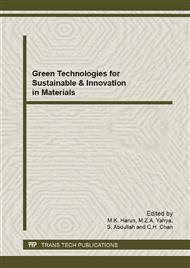p.3
p.8
p.13
p.18
p.28
p.33
p.44
p.49
Production of Herbal Nanopowders: Effect of Milling Time
Abstract:
Several clinical studies have proved the triterpenes in this herb have therapeutic properties and posses significant to health such as antitumor and wound healing. Centella asiatica nanopowders (CANPs) have been produced via top down approach using Planetary Ball Mill (PBM) at 0.5, 4 and 8 hours of milling in optimized condition. CANPs have been characterized using Photo Correlation Spectroscopy (PCS), Field Emission Scanning Electron Microscope (FESEM) and High Performance Liquid Chromatography (HPLC). As a result significant reduction on size was observed as increased a milling time by comparing their z-Average (nm) and the morphology of CANPs exist in the agglomerated form. The HPLC results showed significant increase in concentration of asiatic acid by comparing the concentration of asiatic acid in extract of CANPs and coarse powders whereby the asiaticoside completely disappeared after milling. Thus, nanoherbal can be said as improving the extraction ratio of asiatic acid compared to the coarse powders due to the smaller particle size and larger surface area and the disappearance of asiaticoside still not completely understood.
Info:
Periodical:
Pages:
3-7
Citation:
Online since:
April 2013
Authors:
Keywords:
Price:
Сopyright:
© 2013 Trans Tech Publications Ltd. All Rights Reserved
Share:
Citation:


